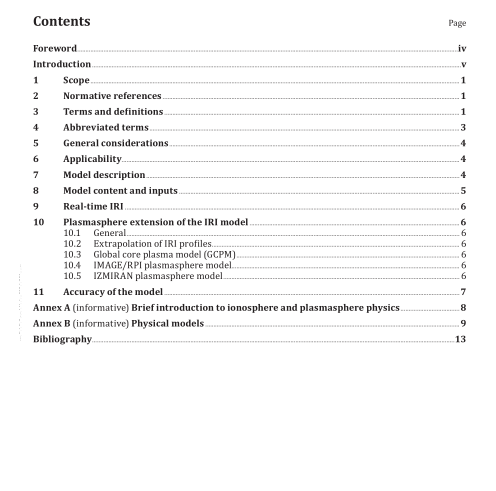ISO 16457:2022 pdf download.Space environment (natural and artificial) — The Earth’s ionosphere model — International reference ionosphere (IRI) model and extensions to the plasmasphere.
5 General considerations
This model for the representation of the ionospheric and plasmaspheric plasma parameters is important to a wide spectrum of applications. Electromagnetic waves travelling through the ionized plasma at the Earth’s environment experience retardation and refraction effects. A remote sensing technique relying on signals traversing the ionosphere and plasmasphere therefore needs to account for the ionosphere- plasmasphere influence in its data analysis.
Applications can be found in the disciplines of altimetry, radio astronomy, satellite communication, navigation and orbit determination. Radio signals, transmitted by modern communication and navigation systems, can be heavily disturbed by space weather hazards. Thus, severe temporal and spatial changes of the electron density in the ionosphere and plasmasphere can significantly degrade the signal quality of various radio systems which even can lead to a complete loss of the signal.
Model-based products providing specific space weather information, in particular now- and fore-cast of the ionospheric state, serve for improvement of the accuracy and reliability of impacted communication and navigation systems. For high frequency radio communication, a good knowledge of the heights and plasma frequencies of the reflective layers of the ionosphere and the plasmasphere is critical for continuous and high-quality radio reception. High frequency communication remains of great importance in many remote locations of the globe.
The model helps to estimate the effect of charged particles on technical devices in the Earth’s environment and defines the ionosphere-plasmasphere operational environment for existing and future systems of radio communication, radio navigation, and other relevant radio technologies in the medium and high frequency ranges.
6 Applicability
There are a multitude of operational usages for ionospheric models, of which the most important are outlined in this clause. Operators of certain navigational satellite systems such as GPS (USA), GLONASS (Russia), BeiDou (China) and GALILEO (Europe) 1) require ionospheric predictions to mitigate losses of navigation signal phase and/or amplitude lock, as well as to maintain accurate orbit determination for all its satellites. Users of global navigation satellite systems need precise ionospheric models to increase the accuracy and to reduce the precise positioning convergence time [57][58] .
Radio and television operators using LF, MF, HF, VHF, UHF satellite or ground stations require ionospheric parameters for efficient communications and for reducing interferences. Space weather forecasters have a great need for accurate ionospheric models to support their customers with reliable and up-to-the-minute space weather information. Ionospheric models are also used in the aeronautical and space system industries and by governmental agencies performing spacecraft design studies. Here the models help to estimate surface charging, sensor interference and satellite anomaly conditions. Users also apply ionospheric models to mitigate problems with HF communications, HF direction finding, radar clutter and disruption to ELF/VLF communications with underwater vehicles. Insurance companies estimating the cost of protecting human health in space and satellites make use of ionospheric models.
Scientists using remote sensing measurement techniques in astronomy, biology, geology, geophysics and seismology require parameter estimates for compensating the effects of the ionosphere on their observations. An ionospheric model can be also used to evaluate tomographic, radio occultation, and other similar techniques, by providing the ground-truth background model for test runs. Amateur radio operators, as well as students and teachers in space research and applications, also use ionosphere parameters. This document may be also applied for ray-path calculations to assess the performance of a particular ground-based or space-borne system. Monthly medians of ionospheric parameters are useful for HF circuit and service planning, while maps for individual days and hours aid frequency management and retrospective studies.
7 Model description
The first version of the IRI model, IRI-1979, and its mathematical build-up is described in References [18], [19] and [20]. The most detailed description of the model and the mathematical formulas and methods used is given in a 155-page report about IRI-1990 [2] . The next significant updates of the model were introduced with IRI-1995 [5] , IRI-2000 [3] , IRI-2007 [53],[54] , IRI-2012 [71],[72] and IRI-2016 [73] . The latest version of the model is available from http:// irimodel .org.ISO 16457 pdf download.ISO 16457-2022 pdf download
